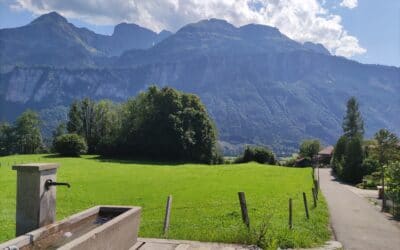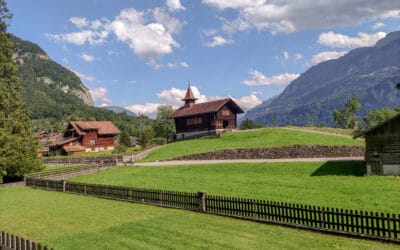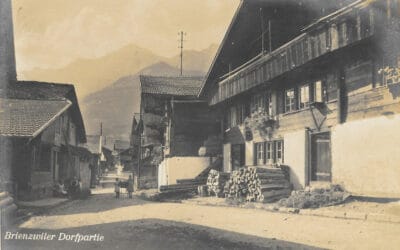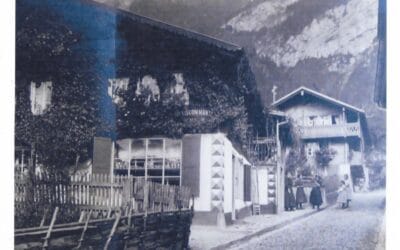
Fresco Schoolhouse/Allmendnussen
“God gave us the nuts; let us crack them together!”
This saying accompanies the sgraffito at the Brienzwiler schoolhouse. It was created by Heinz Schild and his team to commemorate the construction of the new gymnasium.
The Romans, Alemanni, field generals, merchants, travelers, and researchers brought plants, animals, and other things around the world. It is likely that the walnut tree also made its way to us from Greece in this manner.
Not only did people recognize that nuts are very valuable as food and delicacies, but also birds and especially squirrels. These charming animals gathered vast quantities of fruits in the autumn and stored supplies for the winter.
Fortunately, squirrels can be forgetful and don’t find all the nuts again. Later, these fruits sprouted, leading to walnut trees growing in the forests and hedges. Around the village, there were many, partly enormous trees until the late 1940s.
Towards the end of September, a day for the Allmendnussen (collecting nuts in the community) was designated and announced to the citizens. All walnut trees grown in the Bürgerland belonged to the community, and these nuts were “cracked” together in autumn (i.e., collected and fairly distributed).
Runes as Family Signs
The lively and long history of Brienzwiler can also be inferred from the numerous existing house and family signs. The Amacher House is a good example of this. The signs are still visible on the façade today. The old, runelike signs were used to mark everyday objects and as identity signs in the household on important items. These signs were also used to mark lambs, calves, and cattle. A total of 89 runelike house signs have been historically documented.

Oven Houses
Brienzwiler is unique in the Bernese Oberland due to its historical building stock, most of which dates back to the 16th century. The closely situated farmhouses often feature a small economic section. The numerous outbuildings, such as oven houses that were also used for drying fruits, testify to Brienzwiler’s past as a self-sufficient community. There are still about 25 oven houses in Brienzwiler. These outbuildings, typical of the “Flecken” style in the Bernese Oberland, are partially still preserved. Some of them are even still in regular use today.
Fleckenbau
The term “Fleckenbau” refers to the functional expansion of a property with outbuildings that are used for different purposes depending on the season and the specific needs at different times of the year.

Picnic and playground
At the Brienzwiler schoolhouse, families with children will find a playground with various play equipment as well as a sports field. Right next to the playground, there is also a table that provides space for a cozy picnic.
Additional playgrounds can be found in the Doggelerwald as well as in the upper part of the village on Brunnenstrasse.
Clubs
Brienzwiler has a vibrant club life. The approximately 530 residents are organized into 11 local clubs, fostering social and cultural interaction.
- Brienzwiler had a Men’s Choir from 1873 to 1998.
- A Church Choir existed from 1959 to 1997.
- The Drawing School was founded in 1885. Since 1972, girls have also been allowed to attend classes. In recent years, the drawing school has become known beyond the municipality and teaches interested individuals aged 8 to 90.
- The Music Society was founded in 1902.
- The Samaritan Association has been providing first aid for accidents and training in nursing care since 1902.
- The Field Shooting Club (established in 1878) were merged with the Free Shooting Club in 1954.
- The Free Shooting Club were founded in 1908 and still exist today.
- In 1930, 12 snow sports enthusiasts founded the Ski Club.
- The Women’s Gymnastic Club has been promoting sports activities, particularly gymnastics and volleyball, since 1970.
- From 1936 to 2023, there was a Women’s Association in Brienzwiler that engaged in charitable purposes through the sale of handmade goods.
- The Music School and the Music Promotion Association have supported interested music beginners since 1986.
Locations of the Virtual Tour
Nature garden
Nature gardenGoethe on the Wyler BridgeIt is October 13, 1779 – three well-dressed gentlemen step onto the Wyler Bridge down in the valley. One of them would later dictate to his secretary at the Hotel Kreuz in Brienz how they marveled at the “terrifying mountain...
Griid
GriidOltschiburgSecret flight exercise behind the Oltschiburg with the Fieseler StorchOn November 19, 1946, an American Douglas C-53 (Dakota) crashed in rugged terrain at 3350 m above sea level on the Gauli Glacier. All occupants survived the crash landing in the...
Church
ChurchChurchThe small, cozy wooden church with 160 seats was built with contributions from the canton and the Synod Council, as well as countless volunteer hours from the local community, and was consecrated in 1940.The building materials primarily come from the...
Village square
Village squareHistory of the Coat of Arms“Wyler am Brünig”, as Brienzwiler was once called, has always been located on the important transit axis of the Brünig Pass. The old path led from Kienholz (Brienz) via Hofstetten to the “Schloss” district of Brienzwiler and...
Änderdorf
AenderdorfStart of the Zwergliloch TrailThe circular trail to Zwergliloch is a varied hike around Brienzwiler. Duration is approximately 1 hour. NOT SUITABLE FOR PEOPLE WITH MOBILITY IMPAIRMENTS AND SMALL CHILDRENBy Stagecoach over the BrünigThe Brünig Pass road has...




